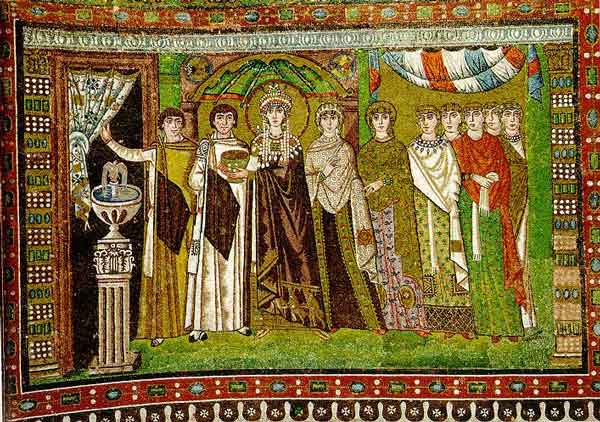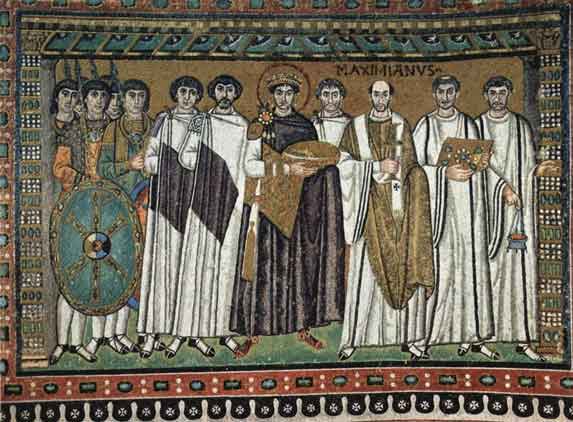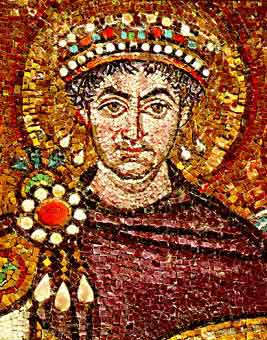.
The Basilica of San Vitale is the most famous monument of Ravenna, Italy and is one of the most important examples of Byzantine art and architecture in western Europe. It was begun by Bishop Ecclesio in 527, and completed by the 27th Bishop of Ravenna, Maximian in 548 during the Byzantine Exarchate of Ravenna. The building combines Roman elements (the dome, shape of doorways, stepped towers) with Byzantine (polygonal apse, capitals, narrow bricks, etc). However, the Basilica is most famous for its wealth of Byzantine mosaics, the largest and best preserved outside of Constantinople itself. The church is of extreme importance in Byzantine art, as it is the only major church from the period of Emperor Justinian to survive virtually intact to the present day, and it is also thought to reflect the design of the Byzantine Imperial Palace Audience Chamber, of which nothing at all survives.
According to legend, the church was erected on the site of the martyrdom of Saint Vitale. However, there is some confusion as to whether this is the Saint Vitalis of Milan, or the Saint Vitale, whose body was discovered together with that of Saint Agricola, by Saint Ambrose in Bologna in 393 AD.
The construction of the church was sponsored by a Greek banker, Julian the Silversmith, of whom very little is known, except that he also sponsored the construction of the Basilica of Sant' Apollinare in Classe at around the same time. The true sponsor may have been the Byzantine Emperor, who used such church construction projects as propaganda and as a way of speeding the incorporation of new territory into the Empire.
Inside, the great triumphal arch is decorated with 15 mosaic medallions, depicting Jesus Christ, the twelve Apostles and Saint Gervasius and Saint Protasius, the sons of Saint Vitale. The cross vaulting in the presbytery is richly ornamented with mosaic festoons of leaves, fruit and flowers, converging on a crown encircling the Holy Lamb. The crown is supported by four angels, and every surface is covered with a profusion of flowers, stars, birds and animals, including many peacocks. On the side walls, the corners (trifora) have mosaics of the Four Evangelists, under their symbols, and dressed in white. Another series of mosaics depicts the story of Abraham and the Sacrifice of Isaac, the story of Moses and the Burning Bush and the story of Abel and Cain. The theopany has a great gold fascia with twining flowers, birds, and horns of plenty. Jesus Christ appears, seated on a blue globe in the summit of the vault, robed in purple, with his right hand offering the martyr's crown to Saint Vitale. On the left, Bishop Ecclesius offers a model of the church.
At the foot of the apse side walls are two famous mosaic panels, depicting the Emperor Justinian, clad in purple with a golden halo, standing next to court officials, Bishop Maximian, soldiers and deacons. On the other side is Empress Theodora, with gold halo, crown and jewels, and a train of court ladies. These panels are almost the only surviving examples of Byzantine secular mosaic art, and offer a glimpse into the glory, splendor and pomp of the Byzantine world.
The design for the Basilica of San Vitale was the model used by Charlemagne for his Palatine Chapel at Aachen in 805, and centuries later was the inspiration for Filippo Brunelleschi in the design for the cathedral of Florence.
The building is one of the eight structures in Ravenna that was included as UNESCO World Heritage Sites in 1996.
Choir mosaics - San Vitale in Ravenna

Theodora

Justinian I, next to him on the right side Bishop Maximian

Justinian I, Detail from the mosaic of St.Vitale.
| Ancient Greece
Science, Technology , Medicine , Warfare, , Biographies , Life , Cities/Places/Maps , Arts , Literature , Philosophy ,Olympics, Mythology , History , Images Medieval Greece / Byzantine Empire Science, Technology, Arts, , Warfare , Literature, Biographies, Icons, History Modern Greece Cities, Islands, Regions, Fauna/Flora ,Biographies , History , Warfare, Science/Technology, Literature, Music , Arts , Film/Actors , Sport , Fashion --- |
Retrieved from "http://en.wikipedia.org/"
All text is available under the terms of the GNU Free Documentation License

